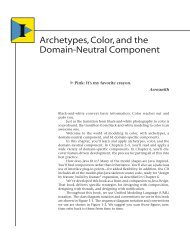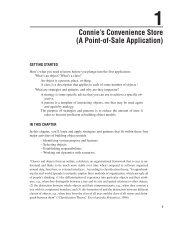Feature-Driven Development - About Peter Coad
Feature-Driven Development - About Peter Coad
Feature-Driven Development - About Peter Coad
You also want an ePaper? Increase the reach of your titles
YUMPU automatically turns print PDFs into web optimized ePapers that Google loves.
■ fosters more creativity and innovation (visual models in color<br />
engage spatial thinking, a creativity must-have before moving into<br />
linguistic and mathematical-logical thinking),<br />
■ encourages exploring “what could be done, what might be done,<br />
and what could make a real difference” before locking oneself into<br />
a fixed system boundary (“the user does this, the system does<br />
that”), and<br />
■ leads to the discovery of feature sets and features that bring significant<br />
business advantage, rather than passively scribing down<br />
the needs for yet another system.<br />
6.4 ESTABLISHING A PROCESS:WHY AND HOW<br />
This section explores these questions:<br />
1. Why use a process?<br />
2. Who selects tools for a process?<br />
3. How might one describe a process?<br />
6.4.1 Why Use a Process?<br />
We think most process initiatives are silly. Well-intentioned managers and<br />
teams get so wrapped up in executing process that they forget that they<br />
are being paid for results, not process execution.<br />
Process for process’ sake alone, as a matter of “process pride,” is a<br />
shame. Having hundreds of pages of steps to execute demoralizes the<br />
team members, to the point that they willingly turn off their minds and<br />
simply follow the steps.<br />
Process over-specification does far more harm than good. The<br />
process takes on a life of its own and consumes more and more time that<br />
could be otherwise spent actually developing software.<br />
A decade ago, one of us wrote up a 110-page process for a large<br />
development team. No matter how hard he tried to defend every<br />
word of his process as something of great value, the team members<br />
looked at the four-page summary in the back and ignored the rest of<br />
what he thought was valuable content. He learned from that experience:<br />
No matter how much process pride you might have as a leader, short<br />
one- to two-page process guides are what developers really want and<br />
need.<br />
No amount of process over-specification will make up for bad people.<br />
Far better: Staff your project with good people, do whatever it takes<br />
to keep them happy, and use simple, well-bounded processes to guide<br />
them along the way.<br />
A well-defined and (relatively speaking) lightweight process can help<br />
your team members work together to achieve remarkable and noteworthy<br />
results. This is significant and worthy of additional consideration.<br />
<strong>Feature</strong>-<strong>Driven</strong> <strong>Development</strong> ▼ 187




